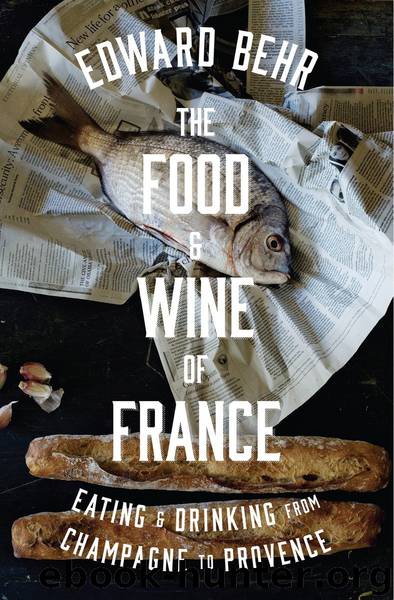The Food and Wine of France by Edward Behr

Author:Edward Behr
Language: eng
Format: epub
Publisher: Penguin Publishing Group
Published: 2016-05-25T13:21:03+00:00
SIXTEEN
Parsleyed Ham
Dijon, Burgundy
Early on a Friday morning in summer, the most serious shoppers at the Halles de Dijon, the central market in the Burgundian capital, were carefully coiffed and dressed older women. In the southwest corner of the market, Christian Sabatier smiled at his customers and looked at ease. Some gray showed in his neatly trimmed dark hair, but he looked in his prime as he, his mother, and two sisters briskly filled orders, slicing and wrapping, pausing only occasionally for a short friendly exchange with a customer. The floor on their side of the counter was raised, so customers looked up as they ordered two or three items from the array of charcuterie. In origin, a charcutier is someone who prepares and sells chair cuite (“cooked meat”), and over time charcutiers came to specialize in items requiring particular skill—hams, sausages, terrines, pâtés. During the few minutes I waited to be served, the most common request was for jambon persillé—“parsleyed ham.” It’s Sabatier’s specialty and Burgundy’s favorite and best-known charcuterie. Customers chose a slice either from a long loaf or from the wide hemisphere of a saladier, a “salad bowl.” In each slice, the green of parsley contrasted appealingly with pieces of pink meat, and there was white fat, including a milky color where the chopped fat had mixed with the meat’s jelly. The combination of jelly and meat makes jambon persillé a relative of headcheese.
Parsleyed ham isn’t strongly salty and intense like dry-cured ham, which must be eaten in paper-thin slices. Jambon persillé is sliced thick—you can eat a lot of it. A good one, such as Sabatier’s, is particularly tender and moist. A chilled slice is firm and holds together, but eaten outdoors and allowed to warm in the sun, it falls apart. The pieces of ham are more sweet than salty, though there’s no more than a touch of sugar in the brine, and at the same time the jelly provides tartness from wine and a little vinegar. There’s also a cautious amount of finely chopped raw garlic; some makers add shallots too. The parsley is so plentiful that it’s almost a vegetable.
When I later telephoned Sabatier to learn more, he gave helpful answers to my questions in his modest, gravelly voice, but he was confused by my interest. I in turn was confused that he was confused, thinking the quality of his jambon persillé was plenty of reason to be calling him up. More than once he asked why I was interested, and the recurring question became a subtheme of our conversation.
I explained that I had heard about him from a friend of mine who had worked in the Burgundy wine trade and lived for two years near Dijon. My friend became interested in jambon persillé and began to search for the best, trying far more examples than he can remember. He said to me, “It’s like asking, ‘How many wines did you taste?’ You only remember the good ones.” He finally concluded that Christian Sabatier’s jambon persillé was best beyond doubt.
Download
This site does not store any files on its server. We only index and link to content provided by other sites. Please contact the content providers to delete copyright contents if any and email us, we'll remove relevant links or contents immediately.
| Eastern European | English, Scottish & Welsh |
| French | German |
| Greek | Hungarian |
| Irish | Italian |
| Mediterranean | Polish |
| Portuguese | Russian |
| Scandinavian | Spanish |
| Turkish |
Biscuits: A Savor the South Cookbook by Belinda Ellis(3905)
Al Roker's Hassle-Free Holiday Cookbook by Al Roker(3177)
A Jewish Baker's Pastry Secrets: Recipes from a New York Baking Legend for Strudel, Stollen, Danishes, Puff Pastry, and More by George Greenstein(3103)
Ottolenghi Simple by Yotam Ottolenghi(3038)
Trullo by Tim Siadatan(2988)
The French Women Don't Get Fat Cookbook by Mireille Guiliano(2983)
Better Homes and Gardens New Cookbook by Better Homes & Gardens(2953)
Bake with Anna Olson by Anna Olson(2931)
Panini by Carlo Middione(2827)
Hot Thai Kitchen by Pailin Chongchitnant(2809)
Nigella Bites (Nigella Collection) by Nigella Lawson(2773)
Momofuku by David Chang(2763)
Modern French Pastry: Innovative Techniques, Tools and Design by Cheryl Wakerhauser(2724)
Salt, Fat, Acid, Heat: Mastering the Elements of Good Cooking by Nosrat Samin(2658)
Tapas Revolution by Omar Allibhoy(2534)
Classic by Mary Berry(2501)
Solo Food by Janneke Vreugdenhil(2491)
Best of Jane Grigson by Jane Grigson(2468)
Okonomiyaki: Japanese Comfort Food by Saito Yoshio(2389)
